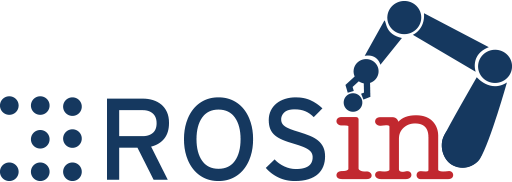-
We will ge giving a tutorial at IROS 2019 in Macau.
-
We presented a tutorial at IEEE IRC 2019. Slides are available here.
-
We presented at the Amazon reMARS conference 2019
-
We presented at the AWS re:invent conference 2018
This is a very deep question with difficult answers. If robotics is meant to equal or even surpass human capabilities, then the language of robotics should be able to describe human behaviour, all the way from muscle activation to intelligence. Achieving this on a single programming language seems like an impossible task. This project proposes a new framework where multiple domain specific languages are used together to describe the behaviour of a robot. Specifically, the Robotics Language (RoL) is a high level robotics programming language that generates ROS c++ nodes, HTML interfaces, or other elements.
Domain Specific Languages are computer languages specialised to a particular application domain. Such languages use the minimum information required to describe a particular concept for a domain, thus present an abstraction of information. This project uses the concept of abstraction languages to simplify programming by combining multiple domain specific languages in a single file.
The base RoL language has a structure similar to standard high-level programming languages
# A simple topic echo node
node(
name:'example echo',
definitions: block(
# the input signal
echo_in ∈ Signals(Strings, rosTopic:'/echo/in', onNew: echo_out = echo_in ),
# the echo signal
echo_out ∈ Signals(Strings, rosTopic:'/echo/out')
)
)The power of the RoL is in its ability to integrate mini-abstraction languages:
# A finite state machine
node(
name:'example state machine',
definitions: block(
# a mini-language: code is defined within `<{ }>`
FiniteStateMachine<{
name:machine
initial:idle
(idle)-start->(running)-stop->(idle)
(running)-error->(fault)-reset->(idle)
(idle)-calibration->(calibrate)-reset->(idle)
}>,
# the start signal
start ∈ Signals(Empty, rosTopic:'/start', onNew: machine.fire('start')),
# the stop signal
stop ∈ Signals(Empty, rosTopic:'/stop', onNew: machine.fire('stop'))
)
)Automatically generated graphical user interfaces in the browser allow for development and monitoring.
RoL contains high-level language element abstractions that are very useful for robotics, such as Interval Temporal Logic for signals.
node(
name:'temporal logic test example',
definitions: block(
# a signal
x ∈ Signals(Booleans, rosTopic:'/temporal_logic/x'),
when(□[1,0](x),
print('always in the last second')),
when(◇[4,1](x),
print('eventually from 4 seconds to 1 second ago')),
when(□[5,0](◇[1,0](x) ∧ ◇[1,0](¬x)),
print('oscillating faster then 1Hz for at least 5 seconds'))
)
)Generated GUIs visualise the signals in time and the outcome of the logic.
The RoL is in practice an open compiler where users can develop their own languages by means of plug-ins. The RoL is programmed in python and uses XML as the internal abstract syntax tree.
-
The Robotics Language
-
The Robotics Language compiler
-
Tutorials
The best way to install is using pip:
pip install RoboticsLanguageTo install this version in github, first git clone:
git clone https://github.com/robotcaresystems/RoboticsLanguage.gitNext, if you are a user run:
pip install .If you are a developer run:
pip install -e .To use the predefined docker scripts first install using pip:
pip install RoboticsLanguageNext, if you are a ROS1 user run in the shell:
rol_dockerIf you are a developer of the Robotics Language run in the shell:
rol_docker_developmentFor ROS2 use:
rol2_dockeror:
rol2_docker_developmentGet the docker image:
docker pull roboticslanguage/rolCreate a folder to share files between docker and your system:
mkdir -p ~/RoL/docker_catkin_wsAdd easy launch commands by copying the lines below into your ~/.bashrc:
# where is your base RoL folder
export ROL_PATH=$HOME/RoL/
# alias to run robotics language docker
alias rol_docker='xhost +local:docker; \
docker run -it --rm \
--name="rol_docker" \
--env=DISPLAY \
--env=XDG_RUNTIME_DIR \
--env=QT_X11_NO_MITSHM=1 \
--device=/dev/dri:/dev/dri \
-v /tmp/.X11-unix:/tmp/.X11-unix:rw \
-v /etc/localtime:/etc/localtime:ro \
-v "${ROL_PATH:?}/docker_catkin_ws:/home/roboticslanguage/catkin_ws/" \
--workdir /home/roboticslanguage/examples \
--net=host \
--add-host rol_docker:127.0.0.1 \
--hostname=rol_docker \
roboticslanguage/rol'
# alias to attach to an existing rol_docker
alias rol_docker_attach='docker exec -it -e "COLUMNS=$COLUMNS" -e "LINES=$LINES" rol_docker bash'Next start the docker image
source ~/.bashrc
rol_dockerYou can open another shell by running rol_docker_attach.
For the first time, setup the user rights in the shared folder:
sudo chown $(whoami):$(whoami) ~/catkin_wsOnce in the docker, everything is configured. You can compile the example:
rol 1_hello_world.rol -cMake sure to source for the first time:
source ~/catkin_ws/devel/setup.bashNow you are ready to launch:
rol 1_hello_world.rol -lThe following command will copy a collenction of examples into the current folder:
rol --copy-examples-hereNext try the examples:
rol 1_hello_world.rol -cMake sure to source for the first time:
source ~/catkin_ws/devel/setup.bashNow you are ready to launch:
rol 1_hello_world.rol -lNote: if you are not using the docker images and you don't have a catkin workspace make sure to run:
mkdir -p ~/catkin_ws/src
cd ~/catkin_ws
catkin initAfter compiling the rol package for the first time make sure to source it:
source ~/catkin_ws/devel/setup.bashThe Robotics Language is continuously evolving. Not all features are implemented. If find errors or you wish a new feature please let us know.
The Robotics Language is developed by Robot Care Systems B.V. (http://www.robotcaresystems.com)

Supported by ROSIN - ROS-Industrial Quality-Assured Robot Software Components. More information: rosin-project.eu
This project has received funding from the European Union’s Horizon 2020 research and innovation programme under grant agreement no. 732287.




